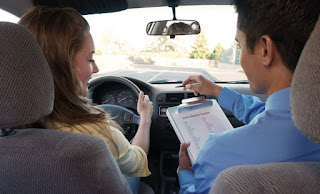The Best Places to Learn How to Drive
Learning to drive is an exciting milestone, but finding the right environment to practice is just as important as the lessons themselves. The location where a new driver practices can greatly influence how quickly they build confidence and master essential skills. At DmvEdu.org, we recommend the following places as the best environments to learn how to drive.
1. Empty Parking LotsWhen you’re just starting out, an empty parking lot is one of the safest and most forgiving places to practice driving. These wide-open spaces allow you to get comfortable with the vehicle’s controls, practice steering, braking, and accelerating without worrying about traffic. Parking lots also provide the perfect opportunity to practice parking, turning, and manoeuvring in tight spaces.
Key Skills to Practice:
Steering control
Braking and accelerating smoothly
Parking (both forward and reverse)
Turning and U-turns
2. Residential Neighborhoods
Once you've mastered the basics, transitioning to a quiet residential neighborhood is the next step. These areas typically have lower speed limits and less traffic, giving new drivers a chance to practice driving in real-world conditions without feeling overwhelmed. Residential streets are great for learning how to navigate intersections, stop signs, and pedestrian crossings.
Key Skills to Practice:
Driving at low speeds
Navigating intersections and stop signs
Watching for pedestrians and cyclists
Practicing safe lane changes
3. Low-Traffic Rural Roads
Rural roads offer a relaxed environment for new drivers to practice driving at slightly higher speeds. With less traffic and fewer distractions than busy city streets, these roads allow drivers to focus on maintaining speed, staying within the lanes, and safely overtaking slower vehicles. However, it's important to be cautious of potential hazards like wildlife, sharp curves, or sudden changes in road conditions.
Key Skills to Practice:
Maintaining speed and following speed limits
Managing curves and hills
Overtaking slower vehicles
Adjusting to different road surfaces
4. City Streets During Off-Peak Hours
Once your teen or new driver feels more confident, driving in the city during off-peak hours (such as mid-morning or early afternoon) can be an excellent way to practice handling more complex driving situations. City streets introduce a variety of challenges, including traffic signals, one-way streets, pedestrians, and public transportation vehicles.
By driving in the city when traffic is lighter, new drivers can build confidence while practicing important skills, such as stopping at traffic lights, merging, and watching for pedestrians.
Key Skills to Practice:
Navigating traffic lights and signals
Merging and changing lanes
Identifying and yielding to pedestrians
Turning on one-way streets
5. Highways (with an Experienced Instructor)
Highway driving can be intimidating for new drivers, but it’s a crucial skill. Once they’ve mastered basic road skills, it’s time to start practicing on highways under the supervision of a qualified instructor. This ensures that they learn how to safely merge onto the highway, change lanes, and exit the freeway, all while maintaining a safe distance from other vehicles.
Key Skills to Practice:
Merging onto the highway
Maintaining highway speeds
Safely changing lanes
Exiting highways
6. Driving Simulators
Many driving schools, including DmvEdu.org, offer driving simulators as a controlled, safe environment for beginners to practice specific scenarios. Simulators are an excellent tool for building confidence before hitting the road, especially when practicing complex situations such as driving in bad weather, night driving, or dealing with unexpected obstacles.
Key Skills to Practice:
Emergency braking
Handling adverse weather conditions
Navigating difficult traffic situations
Practicing nighttime driving
7. Open Rural Highways
Once a driver feels confident in highway driving with an instructor, open rural highways can provide a less intimidating environment for further practice. These roads often have lower traffic volumes than urban highways, making them ideal for drivers to practice longer stretches of driving at higher speeds while gaining more experience in lane discipline and long-distance driving.
Key Skills to Practice:
Maintaining safe following distances
Adjusting to higher-speed driving
Monitoring blind spots
Maintaining focus over long distances
8. Dedicated Driver’s Education Facilities
Many driving schools, including DmvEdu.org, have dedicated facilities where new drivers can practice in a safe, structured environment. These facilities often feature specific setups like road signs, intersections, and parallel parking spaces, allowing students to practice essential driving skills under the guidance of a certified instructor.
Key Skills to Practice:
Parallel parking
Navigating roundabouts and intersections
Emergency stopping
Handling stop-and-go traffic
Final Thoughts
Choosing the right place to practice driving is essential for building confidence and developing safe driving habits. Whether it’s an empty parking lot or a quiet neighborhood street, practicing in a variety of environments will help new drivers master the skills they need to navigate real-world road conditions.



Comments
Post a Comment